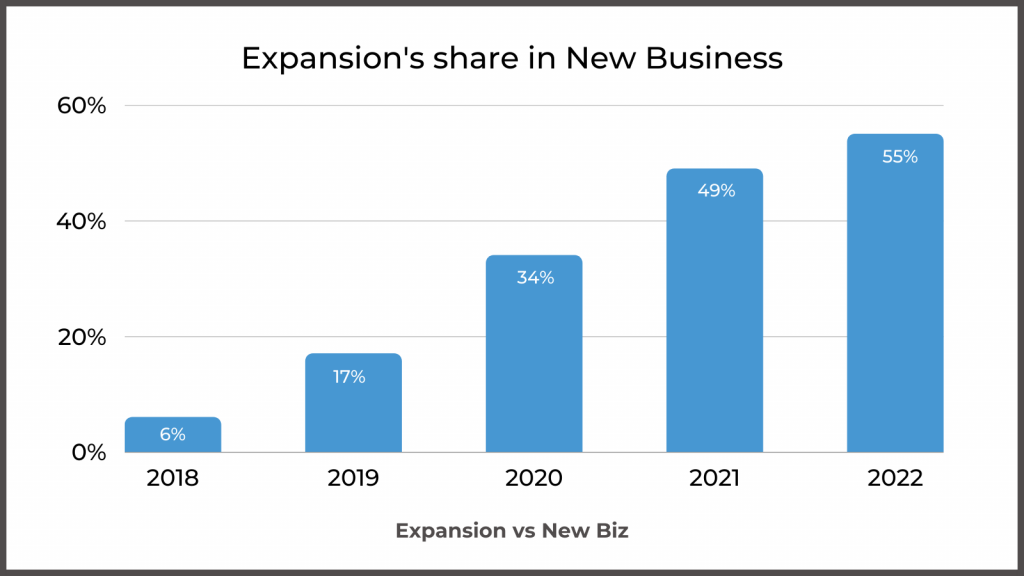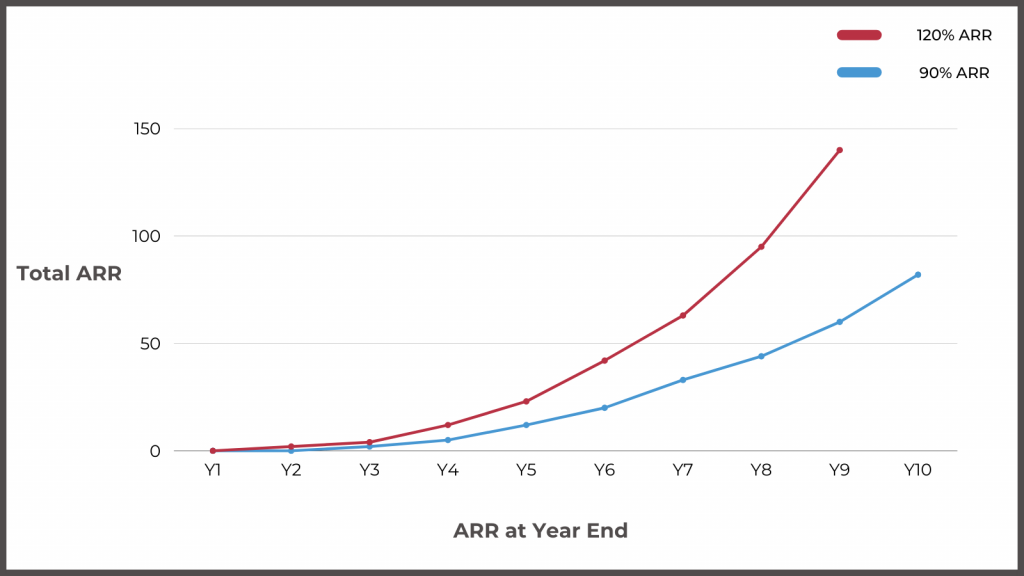Why Existing Customers Matter
I sold enterprise software for 10 years at SAP and Siebel during the license era. If you look at the core economics of that business, the upfront license revenue from a customer is offset by the cost to acquire. Implementation services were dilutive or at best neutral to the operating margin. The reason these companies printed cash is because of the 90%+ operating margin they received from the maintenance revenue stream. All of this when 80%+ of the new license revenue came from existing customers.
So, what is the lesson? It is very expensive to acquire new customers even when you are a virtual monopoly in an enterprise sales motion. Money in the SaaS business is eventually made from existing customers.
It is even more skewed for SaaS companies. As a company grows, the share of revenue from existing customers grows. For the likes of Salesforce, that number is 85%+. Figure below shows the progression for one of our portfolio companies. As ACV grows, which is true for most SaaS companies, the skew is even higher as lands are often expensive and small with 2-3 years payback cycles, but the money is eventually made in expands and renewals. Here is an example of share of new ARR from existing customers for a scaled up SaaS company:

Below is a comparison of two companies, one with 90% Net Dollar Retention and another with 120% Net Dollar Retention. They are spending the same money on sales and marketing as there is no difference in new sales generated every year. Cash burn and growth is substantially different between the two. No points for guessing which ship you want to be on!

What is Customer Marketing
Customer Marketing is a cross functional practice that helps a company leverage its existing customer relationships to maximize its growth, and do so efficiently. It is usually not as important in the first couple of years (It is less Customer Marketing, but more Customer Success at this time). It’s need arises usually in the $5M-$10M ARR range, and increases as ACVs increase. It is also more important where there is not just a renewal motion, but also an expand motion.
There are many different activities within customer marketing:
Account Management
Your account managers in large accounts are your most important customer marketing champions. The tasks involved here are joint account planning at least once a year, executive mapping and sponsorship and a conscious effort to expand relationships within the account.
Value Realization Assessments
While trust, chemistry and executive selling are all very critical part of establishing a new relationship, proof of value delivered is the most important aspect of expansion of these relationships. I advise most of my portfolio companies to set up a practice of baselining key metrics at the time of implementation, and measuring these at periodic basis to understand and demonstrate the impact. Even if you have strong champions in your accounts, they also need these tools to triumph over the sceptics or the naysayers.
Account Based Marketing
Today, sophisticated tools are available that allow you to target specific personas in target accounts, and sequence your communication through well designed playbooks. Tools like DemandBase or 6Sense are the ones that help you do this.
Customer Reviews
Sites like G2, Product Hunt and Capterra are often used by prospects to search and shortlist SaaS companies. Getting your customers to post good reviews on your company is something that requires a deliberate effort. Even better if some of them are willing to make joint social media posts or allow you to use them in your social media content.
User Group
User groups are one of the best ways to let your customers market you. Once you have sufficient number of customers, create users groups where customers can share their successes, examples, how to’s, …and create an engaged community. It can also be an important input channel to your product roadmap.
Annual Customer Event
Similar to the last one, this is a place where you get your customers together, typically once a year to showcase their success (not yours), your roadmap, new releases, etc. Your champions within your customers feel good about meeting their tribe from other companies, share their stories, their frustrations, and be at a place where they are pampered.
Organizational considerations
The challenge with customer marketing is that it is a responsibility of many and, therefore, of none. Case studies are usually championed by product marketing, content marketing uses them (usually part of the demand generation marketing team), sales teams needs to use customer references during sales and also provide access to product marketing to create reference stories. Customer Success usually has the best knowledge of who the best customers are as they see the engagement level with the product.
So whose job is customer marketing. Mostly the CEO, or in some cases CRO. Good SaaS companies have started to think about a Director/ VP of Customer Advocacy whose role cuts across the entire chain, though they are rarely empowered. My bias though is for this role to report to the VP of Product Marketing, even though no answer is perfect.
As we start staring at a downcycle, CAC/ burn considerations will force many SaaS companies to think harder about generating more revenue from existing customers, and also leverage existing customers better across the funnel – both the generate new demand, and also to leverage them to close new deals. It will be a wise move on part of the founders to rethink these activities as a coherent function, and have a strong leader lead it.
As always, whether you agree or disagree, I would love to hear your thoughts on it. Also, if you are building something that impacts customer marketing, I would love to talk to you.
Authored by Alok Goyal
Image Attribution Business handshake photo created by rawpixel.com – www.freepik.com

